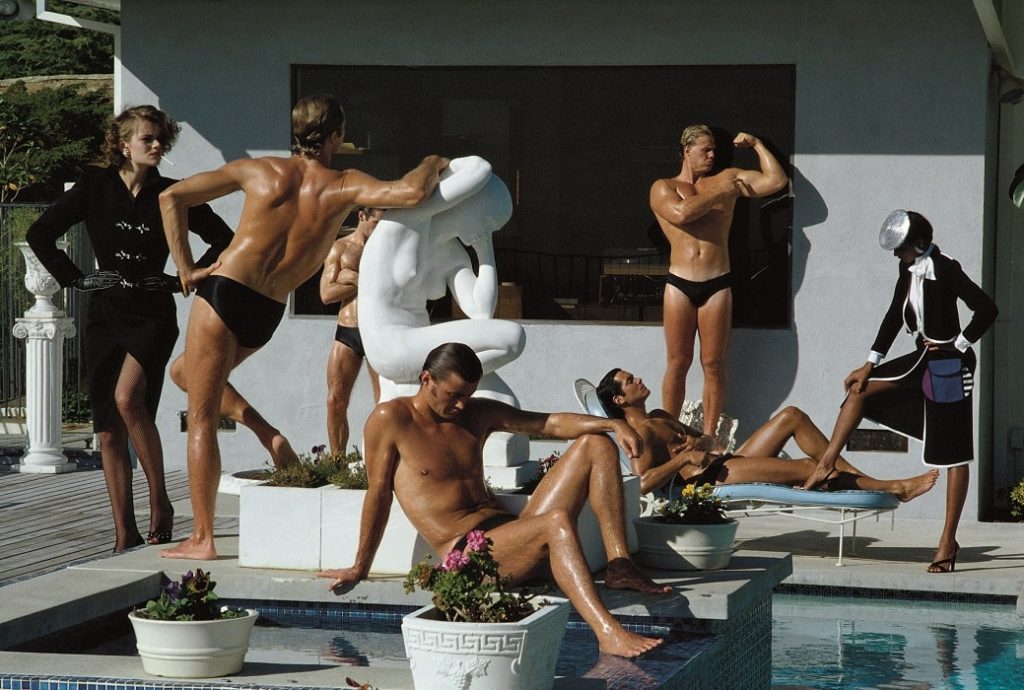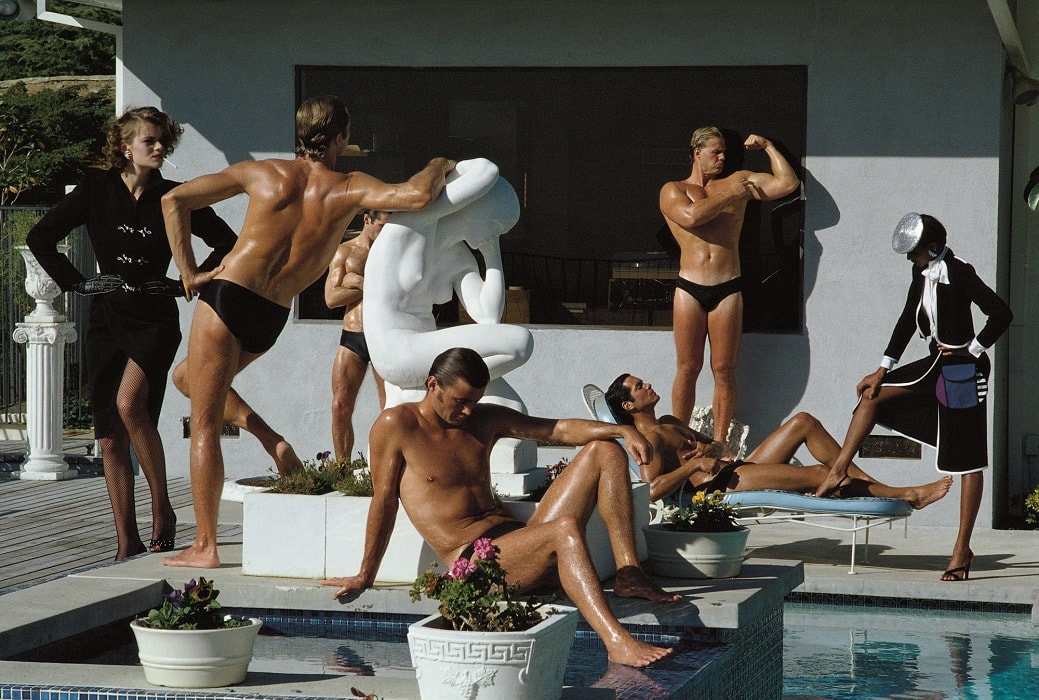Also in 2020, for the 9th time already, the EMOP Berlin – European Month of Photography will take place throughout the month of October. This month, more than 100 galleries, museums and cultural institutions invite visitors to discover the multifaceted nature of the medium of photography.

© Helmut Newton Estate / Courtesy: Helmut Newton Foundation
Exhibition highlights of the photo festival
– the revolutionary solo show hagiography Biorobotica by Andreas Mühe, starting October 9th in the St. Matthäus-Kirche in Tiergarten (Matthäikirchplatz at the Kulturforum)
– the relentless exhibition Palermo and the Fight against the Mafia by the legendary photographer Letizia Battaglia, already from September 24 at the Italian Cultural Institute
– unique contemporary historical documents in The Proletarian View, 1920s workers’ photography, from October 1 at the Bröhan Museum
Traditionally the festival month starts with the EMOP Opening Days. From October 1 to 4, under the title “Photography between Art, Politics and Mass Media”, various panels, talks and discussion events on current topics will take place at the Akademie der Künste on Pariser Platz:
The future of photography education: What does training for contemporary photography look like? How are the most important European training centers positioned?
Panel with Tina Bara (photographer, Professor HGB Leipzig), Ann-Christin Bertrand (ECAL Lausanne, curator), Marta Gili (Director ENSP, Arles), Timothy Persons (Gallery Persons Project, Berlin), Linn Schröder (Ostkreuz photographer, Professor HAW Hamburg, Ostkreuzschule), Frank Schumacher (Lette Verein, Berlin).
Photography and the institutions: Does Germany need a national institute for photography?
What role do museums, galleries etc. play?
Keynote: Thomas Weski (Curator, Foundation for Photography and Media Art with Archive Michael Schmidt, Berlin); Panel with Simone Klein (Consultant for Photography and Art Advisor, Cologne), Robert Morat (Robert Morat Gallery, Berlin), Kito Nedo (Freelance Journalist, Berlin), Anne Schwanz (Gallery Office Impart, Berlin), Thomas Seelig (Museum Folkwang, Essen).
Photography between art and mass medium: discussion forum on current aesthetic developments in photography from a curatorial and media-theoretical perspective.
With Jörg Colberg (photoblog “Conscientious”, USA), Florian Ebner (Centre Pompidou, Paris), Anika Meier (art historian and freelance author, Berlin), Kathrin Peters (Professor of History and Theory of Visual Culture, UdK, Berlin), Ingo Taubhorn (curator Deichtorhallen, Hamburg).
The year 1990, capturing the new (and the old) time.
Panel with Florian Ebner (Centre Pompidou, Paris), Anna-Beata Bohdziewicz (photographer, Warsaw), Ute Mahler (photographer, co-founder of Ostkreuz-Agentur, Berlin), Arwed Messmer
(photographer, Potsdam), Iren Stehli (photographer, Prague), Jan Wenzel (publisher, ed. “Expose the Year 1990”, Leipzig).
Female Artists’ Talk
with Stefanie Moshammer (artist and photographer, Vienna) and Johann König (König Galerie, Berlin)
Film program of the EMOP Opening Days
The EMOP Opening Days will also include a photo film program with rare “treats”. The genre of photo film is based on still images that are perceived as movement in the montage, and which merge into a narrative that can be as fictional as it is documentary. Often combined with a commentary, the photographs gain a new context. Thus in Jutta Brückner’s Doing Right and Shy no one is shy of the family pictures, accompanied by her mother’s monologue, in which the family pictures, through works by August Sander and Abisag Tüllmann, among others, undergo a supra-individual expansion. For Salut les Cubains, on the other hand, Agnès Varda uses exclusively her own photographs taken during a trip to Cuba in 1963. Waiting by Peter Nestler describes the events surrounding a mining accident in Silesia in the 1930s. No less than three films deal with the former GDR: Helke Misselwitz undercut the commission for an anniversary film by showing a haunting portrait of a woman in 35 photos, but whose individuality did not correspond to the official image of women. The photographer Tina Bara takes a journey through the 1980s, when many people withdrew into parallel lives, using her archive as a guide. In Radfahrer Marc Thümmler reconstructs the Stasi’s interpretation of Harald Hauswald’s photos. Elfi Mikesch documents the legacy of the Red Army at the Wünsdorf site. What becomes visible is a city in which the hierarchy of the military hierarchy is as clear as the love of culture.
The following films run in LOOP:
Chris Marker La Jetée (F 1962), 28 min
Agnès Varda Salut les Cubains (F 1963), 30 min
Jutta Brückner Tue recht und scheue niemand – Das Leben der Gerda Siepenbrink (1975), 65 min
Helke Misselwitz 35 Fotos – Bilder aus einem Familienalbum (1988), 7 min
Peter Nestler Das Warten (Väntan) (1985), 6 min
Marc Thümmler Radfahrer (2008), 27 min
Tina Bara Lange Weile (2017), 60 min
Elfi Mikesch Wünsdorf (2020), 32 min
The films will be shown twice a day between 11:00 am and 7:30 pm in the Black Box at Pariser Platz, on October 1 three times a day between 12:00 and 24:00. Admission is free and access is possible at all times, depending on the number of seats available and in compliance with hygiene measures.
A further focus is the events surrounding the central exhibition CONTINENT – In Search of Europe at the Academy of Arts on Pariser Platz. Guided tours of the artists*, discussion groups as well as artist and BookTalks offer exciting insights into the photographic confrontation of the 23 members of OSTKREUZ – Agency of Photographers with the European present.
Berlin, 1945–2000: A Photographic Subject, at Reinbeckhallen
From September 18, 2020 to January 24, 2021, the Stifung Reinbeckhallen Collection of Contemporary Art presents the exhibition “Berlin, 1945-2000: A Photographic Subject” curated by Candice M. Hamelin. It also acts as part of the EMOP Berlin – European Month of Photography in October 2020.

Silbergelatineabzug (Vintage), 40 x 50 cm, © Maria Sewcz
The exhibition examines the ways in which German and international photographers photographed Berlin between the immediate post-war years and the end of the 20th century. It includes photographs and photo series by 23 photographers who made Berlin their subject and sometimes also the inspiration for their work. More on this in this article.
Ruth & Lotte Jacobi, at Willy-Brandt-Haus
On display is the photographic work of the two sisters from one of the oldest photographer families in pre-war Germany. While Lotte Jacobi became famous as a representative of New Photography as early as the 1920s with her portraits of Albert Einstein, Käthe Kollwitz, Lotte Lenya, Klaus and Erika Mann, among others, her sister Ruth’s work is still largely unknown today; it includes portraits, still lifes, reportage, travel, plant and experimental photography.
Paris by feet, at argus fotokunst
The GDR photographer Roger Melis was allowed to travel to the Seine in 1982. During his daily walks through the city, he took famous photographs of this place of longing. His street photography shows normal Parisian everyday life. At the same time, he created his own individual portrait of Paris. The resulting book became a cult.
Migration as Avant-Garde, at C/O Berlin
In his long-term project (2008-2017), Michael Danner weaves his own photographs, archival footage and quotes from Hannah Arendt associatively into a visual dialogue about one of the oldest phenomena of mankind: movement from one place to another. The result is a moving, critical and stirring contribution about the borders of Europe and a counter-proposal to the classic narrative of news images.

Masculinity: Liberation through Photography, im Gropius Bau
At a time when classical images of masculinity are in crisis and concepts such as “toxic” and “fragile” masculinity are shaping social discourses, over 300 works by 50 international women artists offer a panorama of the cinematic and photographic examination of the masculine in all its contradictions and complexity. With works by Laurie Anderson, Richard Avedon, Rotimi Fani-Kayode, Peter Hujar, Isaac Julien, Annette Messager and Catherine Opie, among others.
Blind photographers* inside, in f 3 – free space for photography.
Four photo authors – Susanne Emmermann, Mary Hartwig, Silja Korn, Gerald Pirner – who have gone blind in the course of their lives, deal with the impossible: seeing. For their photographs they use the technique of light painting. In completely darkened rooms, they work out the aspects of a picture with different light sources.
The complete EMOP program for Berlin:






